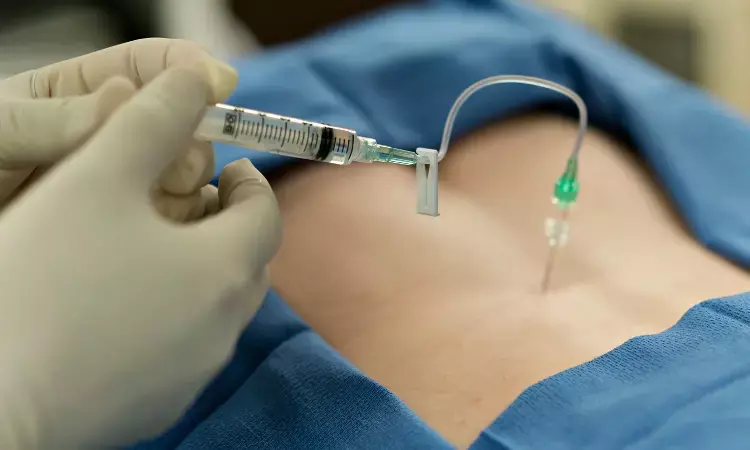- Home
- Medical news & Guidelines
- Anesthesiology
- Cardiology and CTVS
- Critical Care
- Dentistry
- Dermatology
- Diabetes and Endocrinology
- ENT
- Gastroenterology
- Medicine
- Nephrology
- Neurology
- Obstretics-Gynaecology
- Oncology
- Ophthalmology
- Orthopaedics
- Pediatrics-Neonatology
- Psychiatry
- Pulmonology
- Radiology
- Surgery
- Urology
- Laboratory Medicine
- Diet
- Nursing
- Paramedical
- Physiotherapy
- Health news
- Fact Check
- Bone Health Fact Check
- Brain Health Fact Check
- Cancer Related Fact Check
- Child Care Fact Check
- Dental and oral health fact check
- Diabetes and metabolic health fact check
- Diet and Nutrition Fact Check
- Eye and ENT Care Fact Check
- Fitness fact check
- Gut health fact check
- Heart health fact check
- Kidney health fact check
- Medical education fact check
- Men's health fact check
- Respiratory fact check
- Skin and hair care fact check
- Vaccine and Immunization fact check
- Women's health fact check
- AYUSH
- State News
- Andaman and Nicobar Islands
- Andhra Pradesh
- Arunachal Pradesh
- Assam
- Bihar
- Chandigarh
- Chattisgarh
- Dadra and Nagar Haveli
- Daman and Diu
- Delhi
- Goa
- Gujarat
- Haryana
- Himachal Pradesh
- Jammu & Kashmir
- Jharkhand
- Karnataka
- Kerala
- Ladakh
- Lakshadweep
- Madhya Pradesh
- Maharashtra
- Manipur
- Meghalaya
- Mizoram
- Nagaland
- Odisha
- Puducherry
- Punjab
- Rajasthan
- Sikkim
- Tamil Nadu
- Telangana
- Tripura
- Uttar Pradesh
- Uttrakhand
- West Bengal
- Medical Education
- Industry
Disc measurement, nucleus calibration increase accuracy in lumbar model: Study

Finite element analysis (FEA) is an important tool during the spinal biomechanical study. Irregular surfaces in Finite element analysis models directly reconstructed based on imaging data may increase the computational burden and decrease the computational credibility.
Definitions of the relative nucleus position and its cross-sectional area ratio do not conform to a uniform standard in Finite element analysis.
The computational accuracy and efficiency of in-silico study can be improved in the lumbar Finite element analysis model constructed using smoothened surfaces with measured and calibrated relative nucleus position and its cross-sectional area ratio, reports a recent research conducted at the Department of Orthopedic Surgery and Orthopedic Research Institute, West China Hospital/West China School of Medicine for Sichuan University, China.
The study is published in the Journal of Orthopaedic Surgery and Research.
Jingchi Li and colleagues carried out the study. To increase the accuracy and efficiency of Finite element analysis, nucleus position and cross-sectional area ratio were measured from imaging data.
A Finite element analysis model with smoothened surfaces was constructed using measured values. Nucleus position was calibrated by estimating the differences in the range of motion (RoM) between the Finite element analysis model and that of an in-vitro study.
Then, the differences were re-estimated by comparing the range of motion, the intradiscal pressure, the facet contact force, and the disc compression to validate the measured and calibrated indicators. The computational time in different models was also recorded to evaluate the efficiency.
Computational results indicated that 99% of accuracy was attained when measured and calibrated indicators were set in the Finite element analysis model, with a model validation of greater than 90% attained under almost all of the loading conditions.
Computational time decreased by around 70% in the fitted model with smoothened surfaces compared with that of the reconstructed model.
As a result, it was concluded that the computational accuracy and efficiency of in-silico study can be improved in the lumbar Finite element analysis model constructed using smoothened surfaces with measured and calibrated relative nucleus position and its cross-sectional area ratio.
For further reference, log in to:
Li, J., Xu, C., Zhang, X. et al. Disc measurement and nucleus calibration in a smoothened lumbar model increases the accuracy and efficiency of in-silico study. J Orthop Surg Res 16, 498 (2021). https://doi.org/10.1186/s13018-021-02655-4
Dr. Nandita Mohan is a practicing pediatric dentist with more than 5 years of clinical work experience. Along with this, she is equally interested in keeping herself up to date about the latest developments in the field of medicine and dentistry which is the driving force for her to be in association with Medical Dialogues. She also has her name attached with many publications; both national and international. She has pursued her BDS from Rajiv Gandhi University of Health Sciences, Bangalore and later went to enter her dream specialty (MDS) in the Department of Pedodontics and Preventive Dentistry from Pt. B.D. Sharma University of Health Sciences. Through all the years of experience, her core interest in learning something new has never stopped. She can be contacted at editorial@medicaldialogues.in. Contact no. 011-43720751
Dr Kamal Kant Kohli-MBBS, DTCD- a chest specialist with more than 30 years of practice and a flair for writing clinical articles, Dr Kamal Kant Kohli joined Medical Dialogues as a Chief Editor of Medical News. Besides writing articles, as an editor, he proofreads and verifies all the medical content published on Medical Dialogues including those coming from journals, studies,medical conferences,guidelines etc. Email: drkohli@medicaldialogues.in. Contact no. 011-43720751


